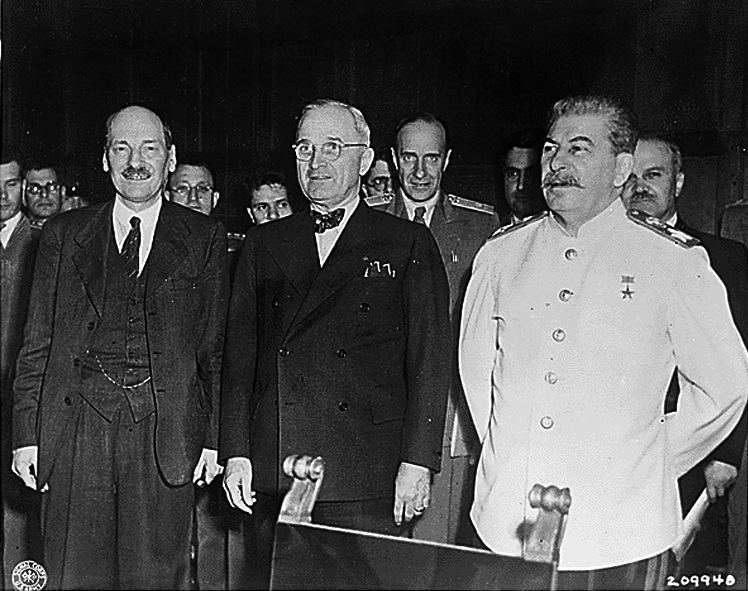 | ||
The Potsdam Agreement (German: Potsdamer Abkommen) was the agreement between three of the Allies of World War II, United Kingdom, United States, Union of Soviet Socialist Republics, for the military occupation and reconstruction of Germany—referring to the German Reich with its pre-war 1937 borders including the former eastern territories—and the entire European theatre of War territory. It also included Germany's demilitarisation, reparations and the prosecution of war criminals.
Contents
Executed as a communiqué, the Agreement was not a peace treaty according to international law, although it created accomplished facts. It was superseded by the Treaty on the Final Settlement with Respect to Germany signed on 12 September 1990, 45 years later.
Overview
After the Second World War (1939–45), and the Tehran, Casablanca and Yalta Conferences, the Allies by the Berlin Declaration of June 5, 1945, had assumed supreme authority over Germany. In the Three Power Conference of Berlin (formal title of the Potsdam Conference) from 17 July to 2 August 1945, they agreed to and adopted the Protocol of the Proceedings, August 1, 1945, signed at Cecilienhof Castle in Potsdam. The signatories were General Secretary Joseph Stalin, President Harry S. Truman, and Prime Minister Clement Attlee, who, as a result of the British general election of 1945, had replaced Winston Churchill as the UK’s representative. The Provisional Government of the French Republic agreed with reservations on August 4.
Protocol
In the Potsdam Agreement (Berlin Conference) the Allies (UK, USSR, USA) agree:
- Establishment of a Council of Foreign Ministers.
- The principles to govern the treatment of Germany in the initial control period.
- A. Political principles. Democratization. Treatment of Germany as a single unit. Disarmament and Demilitarization. Elimination of all Nazi influence.
- B. Economic principles. Reduction or destruction of all civilian heavy-industry with war-potential, such as shipbuilding, machine production and chemical factories. Restructuring of German economy towards agriculture and light-industry.
- Reparations from Germany.
- Disposal of the German Navy and merchant marine.
- City of Königsberg and the adjacent area (then East Prussia, now Kaliningrad Oblast).
- War criminals
- Austria:
- Poland
- Conclusion on peace treaties and admission to the United Nations organization.
- Territorial Trusteeship
- Revised Allied Control Commission procedure in Romania, Bulgaria, and Hungary
- Orderly transfer of German Populations
- Oil equipment in Romania
- Iran
- The international zone of Tangier.
- The Black sea straits.
- International inland waterways
- European inland transport conference.
- Directives to the military commanders on allied control council for Germany.
- Use of Allied property for satellite reparations or war trophies
- Military Talks
Moreover, towards concluding the Pacific Theatre of War, the Potsdam Conference issued the Potsdam Declaration, the Proclamation Defining Terms for Japanese Surrender (26 July 1945) wherein the Western Allies (UK, US, USSR) and the Nationalist China of General Chiang Kai-shek asked Japan to surrender or be destroyed.
Aftermath
Already during the Potsdam Conference, on 30 July 1945, the Allied Control Council was constituted in Berlin to execute the Allied resolutions (the "5D's"):
Territorial changes
The northern half of the German Province of East Prussia, occupied by the Red Army during its East Prussian Offensive followed by its evacuation in winter 1945, had already been incorporated into the Soviet territory by amendment of the country's constitution. The Western Allies promised to support the annexation of the territory north of the Braunsberg—Goldap line when a Final German Peace Treaty was held.
The Allies had acknowledged the legitimacy of the Polish Provisional Government of National Unity, which was about to form a Soviet satellite state. Urged by Stalin, the UK and the US gave in to put the German territories east of the Oder-Neisse line from the Baltic coast west of Świnoujście up to the Czechoslovak border "under Polish administration"; allegedly confusing the Lusatian Neisse and the Nysa Kłodzka (Glatzer Neisse) rivers. The proposal of a (more historic) Oder-Bóbr-Kwisa line was rejected by the Soviet delegation. The cession included the former Free City of Danzig and the seaport of Stettin on the mouth of the Oder River (Szczecin Lagoon), vital for the Upper Silesian Industrial Region.
Expulsions
In the course of the proceedings, Polish communists had begun to suppress the German population west of the Bóbr river to underline their demand for a border on the Lusatian Neisse. The Allied resolution on the "orderly transfer" of German population became the legitimation of the expulsion of Germans from the nebulous parts of Central Europe, if they had not already fled from the advancing Red Army.
The expulsion of ethnic Germans by the Poles concerned, in addition to Germans within areas behind the 1937 Polish border in the West (such as in most of the old Prussian province of West Prussia), the territories placed "under Polish administration" pending a Final German Peace Treaty, i.e. southern East Prussia (Masuria), Farther Pomerania, the New March region of the former Province of Brandenburg, the districts of the Grenzmark Posen-West Prussia, Lower Silesia and those parts of Upper Silesia that had remained with Germany after the 1921 Upper Silesia plebiscite. It further affected the German minority living within the territory of the former Second Polish Republic in Greater Poland, eastern Upper Silesia, Chełmno Land and the Polish Corridor with Danzig.
The Germans in Czechoslovakia, known as Sudeten Germans but also Carpathian Germans, were expelled according to the Beneš decrees. —from the Sudetenland region, where they formed a majority, from linguistic enclaves in central Bohemia and Moravia, as well as from the city of Prague.
Though the Potsdam Agreement only refers to Poland, Czechoslovakia and Hungary, expulsions also occurred in Romania, where the Transylvanian Saxons were deported and their property disseized, and in Yugoslavia. In the Soviet territories, Germans not only were expelled from northern East Prussia (Oblast Kaliningrad) but also from the adjacent Lithuanian Klaipeda Region and other lands settled by Baltic Germans.
